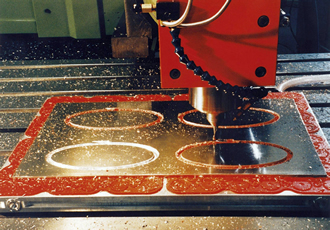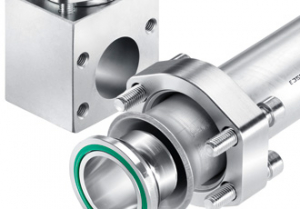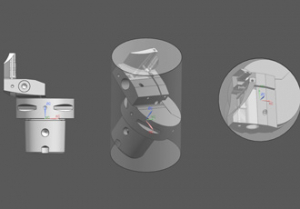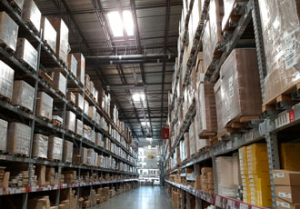Manufacturers under pressure should consider vacuum technology

During the past three decades, Thame Workholding has established a wealth of experience providing standard and special workholding solutions using vacuum technology to all sectors of industrial manufacturing. Leading businesses in the aerospace, medical, motorsport, electronics and precision subcontracting sectors have successfully applied vacuum workholding technology supplied by Thame.
Vacuum workholding is a highly effective technique for holding thin or irregular shaped or non-magnetic raw material or parts. Although parts with a large surface area are ideal, as the holding force is increased, there are techniques for holding small parts as well. Vacuum workholding can be applied to most machining techniques, including milling, turning, grinding, engraving and drilling.
“Vacuum workholding offers a number of benefits,” explains Sales Director Maurice Day, “including clamping without distortion or clamping marks; very fast clamp and unclamp cycle times; machining without vibration which prevents chatter marks; as the machining area is free from clamps multi-surface working is possible; vacuum is suitable for many materials and adaptable to many different machining processes.”
On every surface of an object there is an even pressure acting upon it due to the surrounding atmosphere, this is approximately 1 bar (10.9kg per square metre or 14.5 pounds per square inch). Using a vacuum pump, the air underneath the component is drawn away, so that the pressure load on these lower surfaces is partly removed; the clamping or holding force results from the difference in pressure between the upper and lower component surfaces.
The amount of one-sided pressure is dependent on the amount of vacuum generated. Although modern vacuum pumps reach a vacuum of approximately 990mbar (around 98 per cent of the atmospheric air pressure), for most practical applications Thame suggest a working vacuum of 0.8 bar. The exact clamping force on a component is proportional to its surface area. So, for a component of 200 mm by 400 mm with an applied vacuum of 0.8 bar, the clamping force can be calculated as 6.4 kN. Of course, the weather and position above sea level of the vacuum application will have an effect on the actual clamping force obtained for a specific application.
Thame offer a number of vacuum workholding solutions, and the practical experience the company’s engineers have gained ensure they can recommend the system best suited to the application. Such as the Vac-Mat, a vacuum workholding system that can be cut right into because the patented plastic mat keeps the part securely held down even when penetrated by a cutting tool. So windows, pockets and profiles can by machined in one setup providing tremendous productivity gains over conventional vacuum fixtures.
The 300 by 200 mm soft plastic mat that is just 2,.5 mm thick and has a top face with 77 vacuum suckers in two different sizes each with a fine hole in the centre and a raised lip. On the underside of the mat there are six lugs that locate in the Vac-Mat fixture plate and a distribution grid of grooves to each hole for extracting the air. A lip around the outside mat edge ensures no leakage.
Perhaps the most common form of vacuum clamping, grid type vacuum fixtures are anodised high-tensile aluminium fixture plates that provide an excellent platform for clamping workpieces during milling or grinding. The neoprene seal pressed into the grid slots offers a good seal on uneven surfaces to securely hold the workpiece.
Slot vacuum fixtures are extremely light and thin fixture plates are made from anodised high tensile aluminium and are especially suited for small parts during light milling and drilling and all kinds of engraving. Rubber adaptor mats are used to permit fast changeover and offers high slip resistance to the workpiece. The 28 mm thick plates range from 150 by 100 up to 600 by 400 mm.
Thame’s rotary vacuum fixtures offer a wide scope of application for thin-walled parts, aluminium and plastic parts, and so on, without causing distortion or clamping marks. Systems can be designed for CNC turning centres, grinding machines and lathes with through spindles. Rotary chucks can go up to 6,000 rpm.
Flip-pod vacuum fixtures provide a modular vacuum clamping system that is ideal for machining plastic, wood, glass and non-ferrous metals using CNC milling, routing and drilling operations. The pods activate on being ‘flipped’ and self-store or nest when not in use. The system reduces set up times between workpiece changeovers and thereby increases productivity. Systems are designed to suit workpiece requirements.
Sinter metal and porous aluminium vacuum fixtures have a porous surface area and are ideally suited for extremely thin workpieces where no deformation is required. Used in silicon wafer production, micro machining and measurement applications plates come in a wide range of sizes and are often made to measure.
When using vacuum to hold parts it may be necessary to review the machining strategy to suit this style of workholding. Vacuum workholding is less effective on smaller components, therefore rather than machining individual workpieces it is advantageous to machine several parts from a larger piece of raw material.
Cutting tool technique when using vacuum fixtures tend to improve by using smaller diameter cutters, increasing spindle speeds, feed rates and ramping rather than plunging. Cutting forces need to be considered and on thicker material it may be necessary to employ the use of stops directing the cutting tool pressure toward the stop. Unsuitable or blunt tools increase cutting force pressure and should be avoided.
To ensure any system is running at its optimal level Thame offers a full range of vacuum accessories, such as gauges, neoprene seal, hose, filters, valves, rotation joints, distributors, vacuum grease, and so on.
Similar articles
More from Thame Workholding
- Multi-clamping system saves time during change-over 5th August 2015
- Trueborer is quick and accurate 17th February 2015
- Manufacturers under pressure should consider vacuum technology 10th February 2015
- Thame turns up the efficiency with Powerpull 3rd October 2014



ed.jpg)








Write a comment
No comments